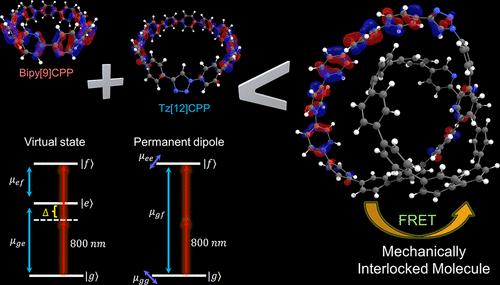Nonlinear Optical Properties of Mechanically Interlocked Nanohoops
IF 15.6
1区 化学
Q1 CHEMISTRY, MULTIDISCIPLINARY
引用次数: 0
Abstract
The design of molecular systems that harness spatial topology to modulate light–matter interactions is a powerful and emerging approach in modern photonics, opening up new possibilities for advanced technologies. In this study, we present the first comprehensive theoretical and experimental investigation of the nonlinear optical (NLO) properties of nanohoop catenanes, which are mechanically interlocked molecular architectures. Specifically, we explored systems based on [9]cycloparaphenylene with 2,2′-bipyridyl (Bipy[9]CPP), [12]cycloparaphenylene with 1,2,3-triazole (Tz[12]CPP), and the nanohoop[2]catenane [9+12] incorporating both units. Herein, we explore how noncovalent topological modifications influence the photophysical behavior of these systems. Using classical and entangled two-photon absorption (TPA and ETPA) spectroscopy, femtosecond transient absorption (fsTA), and time-dependent density functional theory (TD-DFT) calculations, we show that mechanical interlocking introduces strong noncovalent interactions between the rings and the formation of new interlocked-state-specific electronic transitions. Through these measurements and calculations, we find that interlocking leads to the formation of charge-transfer states and nonlinear absorption behavior not present in the individual components. These findings underscore that spatial topology─not just molecular identity or covalent connectivity─can give rise to emergent electronic behavior useful for applications in quantum imaging, optical switching, and other advanced photonic technologies.

机械互锁纳米环的非线性光学性质
利用空间拓扑来调节光-物质相互作用的分子系统设计是现代光子学中一种强大的新兴方法,为先进技术开辟了新的可能性。在这项研究中,我们首次对纳米环链烷的非线性光学(NLO)性质进行了全面的理论和实验研究。具体来说,我们探索了基于[9]环对苯炔- 2,2 ' -联吡啶(Bipy[9]CPP),[12]环对苯炔- 1,2,3-三唑(Tz[12]CPP)和纳米环[2]catenane[9+12]结合这两个单元的体系。在此,我们探讨了非共价拓扑修饰如何影响这些系统的光物理行为。通过经典和纠缠双光子吸收(TPA和ETPA)光谱、飞秒瞬态吸收(fsTA)和时间依赖密度泛函理论(TD-DFT)计算,我们发现机械互锁在环之间引入了强的非共价相互作用,并形成了新的互锁态特定电子跃迁。通过这些测量和计算,我们发现联锁导致了单个组分中不存在的电荷转移态和非线性吸收行为的形成。这些发现强调,空间拓扑──不仅仅是分子同一性或共价连通性──可以产生对量子成像、光开关和其他先进光子技术应用有用的紧急电子行为。
本文章由计算机程序翻译,如有差异,请以英文原文为准。
求助全文
约1分钟内获得全文
求助全文
来源期刊
CiteScore
24.40
自引率
6.00%
发文量
2398
审稿时长
1.6 months
期刊介绍:
The flagship journal of the American Chemical Society, known as the Journal of the American Chemical Society (JACS), has been a prestigious publication since its establishment in 1879. It holds a preeminent position in the field of chemistry and related interdisciplinary sciences. JACS is committed to disseminating cutting-edge research papers, covering a wide range of topics, and encompasses approximately 19,000 pages of Articles, Communications, and Perspectives annually. With a weekly publication frequency, JACS plays a vital role in advancing the field of chemistry by providing essential research.

 求助内容:
求助内容: 应助结果提醒方式:
应助结果提醒方式:


